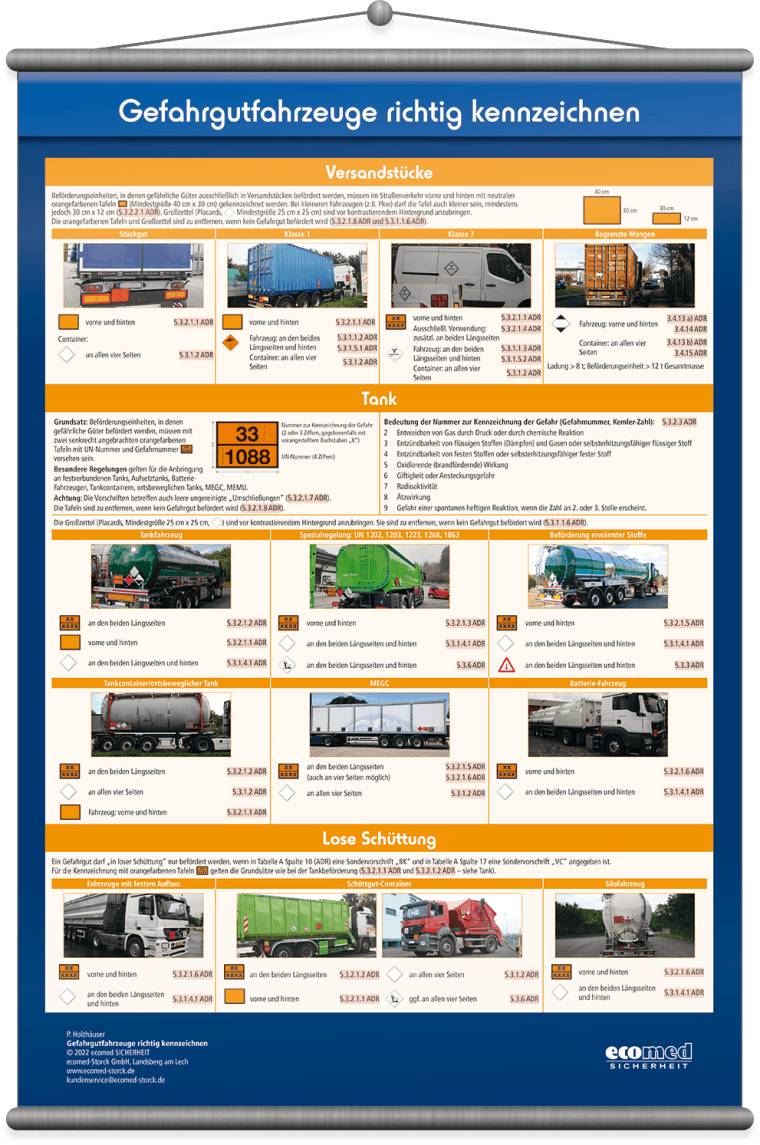
Wall panel, format 70.0 x 100 cm How to safely label dangerous goods shipments! Whether packages are transported by road, rail or water, certain labelling requirements must always be met. Deficiencies in package labelling often lead to complaints and are one of the main reasons for administrative offences in the transport of dangerous goods.On the ‘Safe labelling of dangerous goods packages’ wall chart, you will find the various labelling requirements clearly illustrated. The wall chart serves as a practical aid for packers. All information on shipping dangerous goods is based on the current status of ADN, ADR, RID and IMDG Code.On the wall chart you will first find the basic rules for labelling, which apply to all dangerous goods packaging. This is followed by the special cases:- Overpacking - Salvage - Alignment arrows - Environmentally hazardous substances - Large quantities - Small quantities - Gases - Aerosols - Cooling and conditioning agents - Lithium batteries - Radioactive substances - Special features cl. 4.1 and 5.2Ideally suited as an aid for training and instruction on hazardous goods!

Wall panel, format 70.0 x 100 cmAt a glance: Current licence plates and markings according to dangerous goods legislation. This wall board offers a multimodal compilation of all the current legal status of all the labelling (warning signs, handling signs, etc.) and markings, with a short, concise description of their meaning and potential hazards. Due to the tear-resistant material and the high-quality and dimensionally stable suspension device, the wall board is suitable for both stationary and mobile use in the training area.
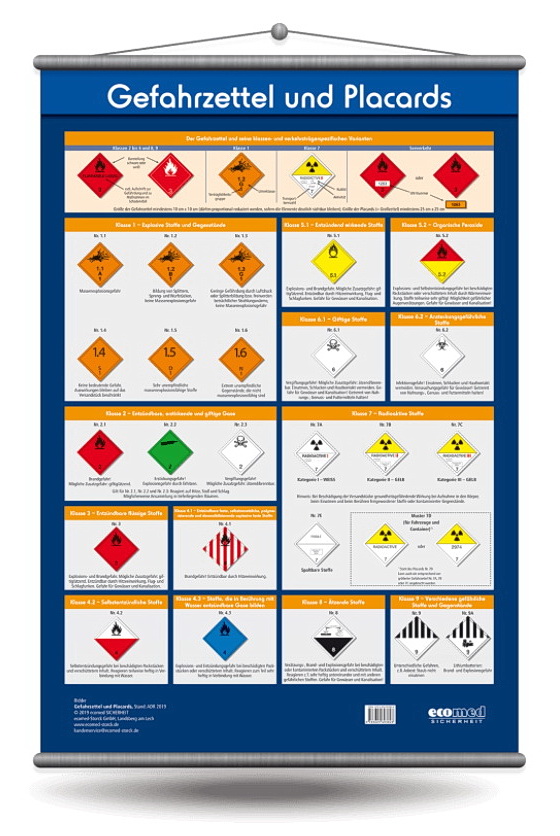
Wall panel, format 70.0 x 100 cm At a glance: The current hazard labels and placards.The hazard labels and placards wall chart offers a multimodal (ADR, RID, IMDG Code, IATA-DGR) compilation of all hazard labels and placards, sorted by class and based on the current legal status, with a short, concise description of the meaning and hazard potential. The individual elements of the various hazard labels are described. References to variants are also included. You will find the following blocks on our wall chart: - The hazard label and its class- and carrier-specific variants- A clear presentation of the symbols and inscriptions/numbers on a ‘standard’ hazard label for classes 2-6, 8 and 9 and the special features of classes 1 (subclass/compatibility group) and 7 (nuclide/activity/transport code). In addition, the possible variant with UN number in the hazard label or the combination of UN number in orange-coloured rectangle in combination with hazard label is listed. - Class 1 - Explosive substances and articles: Presentation of hazard label numbers 1.1 to 1.6 with, in some cases, an exemplary combination of subclass and compatibility group.Class 2 - Flammable, asphyxiating and toxic gases - Class 3 - Flammable liquids - Class 4.1 - Flammable solid, self-reactive, polymerising and desensitised explosive solids - Class 4.2 - Spontaneously flammable substances - Class 4.3 - Substances which, in contact with water, emit flammable gases - Class 5.1 - Flammable substances - Class 5.2 - Organic peroxides - Class 6.1 - Toxic substances - Class 6.2 - Infectious substances - Class 7 - Radioactive substances - Class 8 - Corrosive substances - Class 9 - Miscellaneous dangerous substances and objects Due to the tear-resistant material and the high-quality and dimensionally stable hanging device, the wall board is suitable for both stationary and mobile use in the training area. The blackboard (with hanger) is used as teaching material.
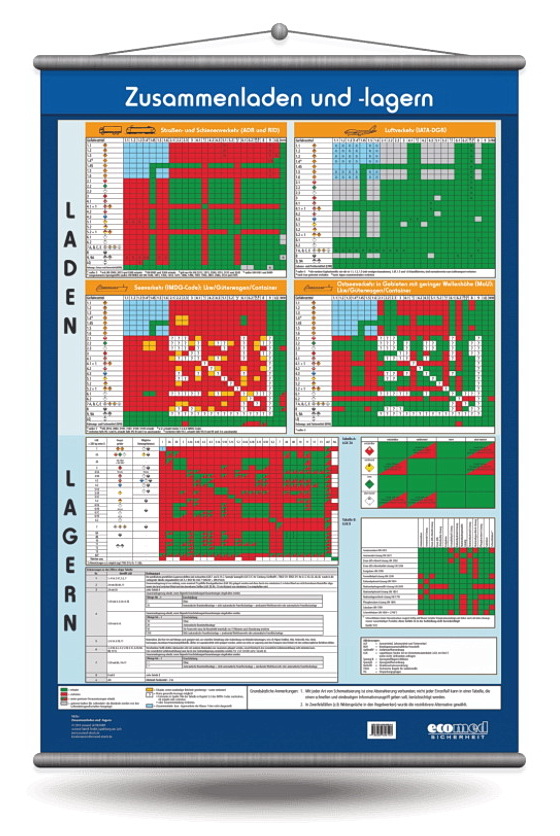
Wall panel, format 70.0 x 100 cm Loading and storing together: everything at a glance! Do you work in delivery transport and have to store and load goods together? Do you know what you have to bear in mind, e.g. what quantity limits there are for storage or which goods have to be kept separate? Then you should have this notice board hanging on your wall so that you are informed about the options for combined loading and storage. And this is what you can see on the board: Road and rail transport (ADR and RID): Do you know which goods labelled with a specific hazard label you are allowed to load together? The prohibited and permitted options in road and rail transport are graphically illustrated on our wall panel. So you can see at a glance what is allowed and what is not! Air transport (IATA-DGR): Depending on the hazard label, the permitted or prohibited options for mixed loading are also shown here. In air transport, some goods must also be kept separate as specified by the respective airline - this aspect is also considered.Maritime transport (IMDG Code): Lorry/freight wagon/container: In addition to the permitted or prohibited options for mixed loading depending on the hazard label, there is also the restriction in maritime transport that the competent authority decides whether goods may be transported together. This category can also be recognised at a glance by its graphic implementation using an orange field. Substances for which a general statement is not possible are marked with a question mark. Of course, it is also explained how you can still reach a decision.Baltic Sea transport with a low wave height (MoU): Lorries/freight wagons/containers:In addition to the simple prohibitions and authorisations, there are also substance groups in Baltic Sea traffic for which no general statement is possible. Here, too, our wall panel marks these with a question mark, but at the same time gives you a hint as to where you can obtain this information.Combined storage according to TRGS 510: The permitted and prohibited options are shown depending on the storage class and hazard label. An additional table describes the quantity dependencies developed by the legislator and lists additional regulations that must be observed, e.g. for explosives. Table A: LGK 2AThis table answers the question under which conditions flammable, oxidising, inert and acutely toxic gases may be stored together. Table B: LGK 8Do you know which acids may be stored together? Table B on our wall chart deals with this issue from formic acid to sulphuric acid. The wall chart is also ideal for training purposes. The sturdy mounting and suspension system guarantee long-term use.
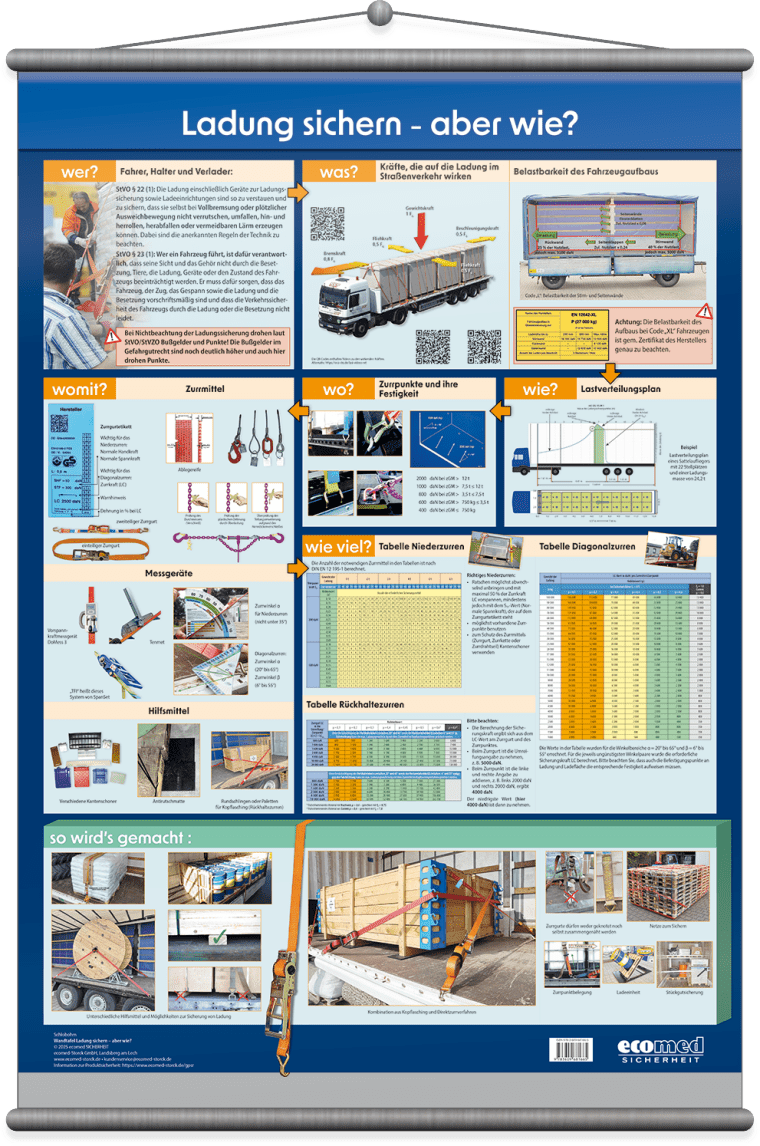
Wall panel, format 70.0 x 100 cm Avoid fines - secure loads correctly! The wall panel shows in words and pictures as well as using lashing tables how to secure loads in accordance with DIN EN 12195-1:2011.The wall chart offers a graphically clear presentation of the most important key points for optimum load securing - from the selection of suitable vehicles to the correct load distribution on the vehicle, suitable lashing equipment and lashing techniques, through to illustrated practical examples.The number of lashing devices can be quickly read off from two tables included in the book if some specific parameters are known. It also explains who in the transport chain is responsible for correct load securing. The wall chart (with hanger) serves as teaching material.
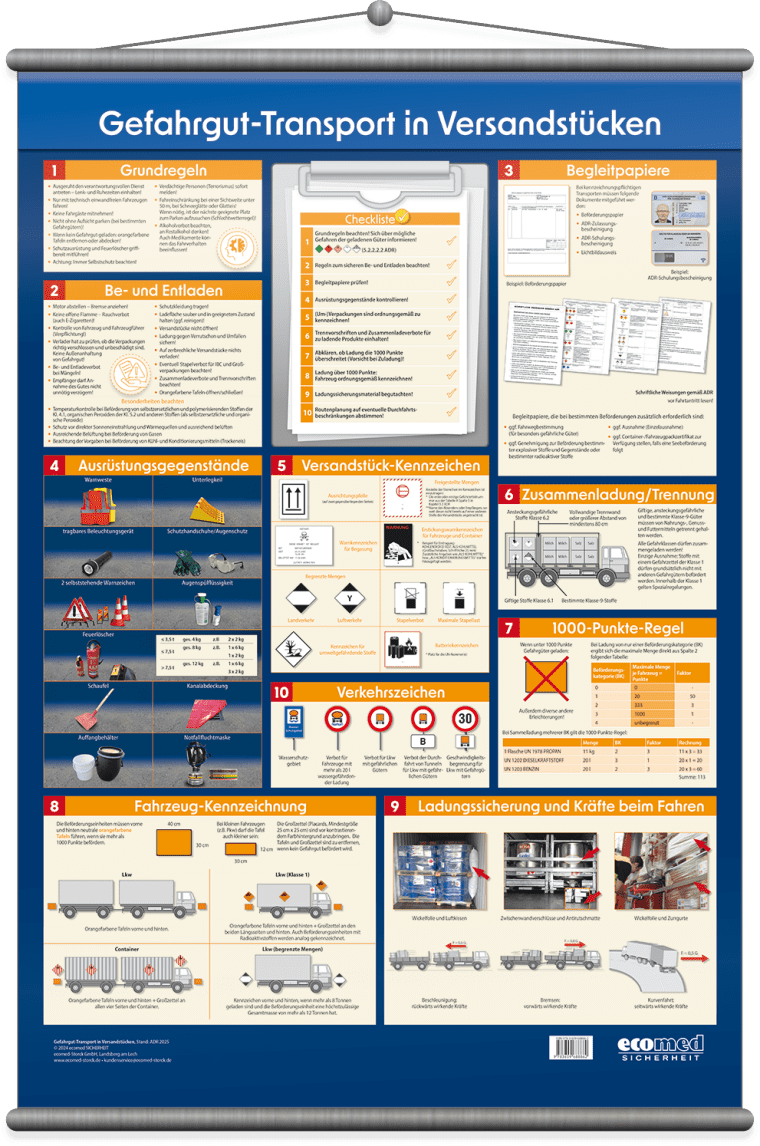
Wall panel, format 70.0 x 100 cm Transport of dangerous goods in packages: Everything important at a glance! Do you ship dangerous goods in packages? If so, you should have this board hanging on your wall so that your drivers can check how to transport dangerous goods safely and in accordance with regulations before setting off. And this is illustrated on the wall panel - based on a checklist with the eleven most important points to be observed in the transport process - in clearly arranged display boxes:- Basic rules: Do you know the nine basic rules for transporting dangerous goods? Your drivers should follow them to avoid accidents. - Hazard classes/hazard labels according to ADR: A clear table describes the hazards posed by the individual hazard classes. - Loading and unloading: What do drivers need to pay attention to here? The important rules are illustrated with graphics.- Accompanying documents: Which documents must be carried and when? The quick check for the driver!- Equipment: What equipment should drivers have with them? Use the overview on the wall panel to quickly check your inventory before you set off. - Package labelling: In which cases must the packages have special labels? - Mixed loading: What are the prohibitions on mixed loading? Which hazardous goods must be transported separately? You will find the answers on the blackboard. - 1000-point rule: What does this rule mean? How is mixed loading calculated? - Vehicle labelling: When, where and how must orange-coloured plates and hazard labels be affixed? - Driving forces and load securing: Graphics and photos illustrate how the load is secured against sliding and in which direction. - Traffic signs: Which special dangerous goods traffic signs mean what? - Behaviour in the event of an accident: What do drivers need to remember in the event of an accident? A yellow warning box points this out to them. The wall panel is also ideal for training purposes. The sturdy mounting and suspension system of the wall board guarantee long-term use.
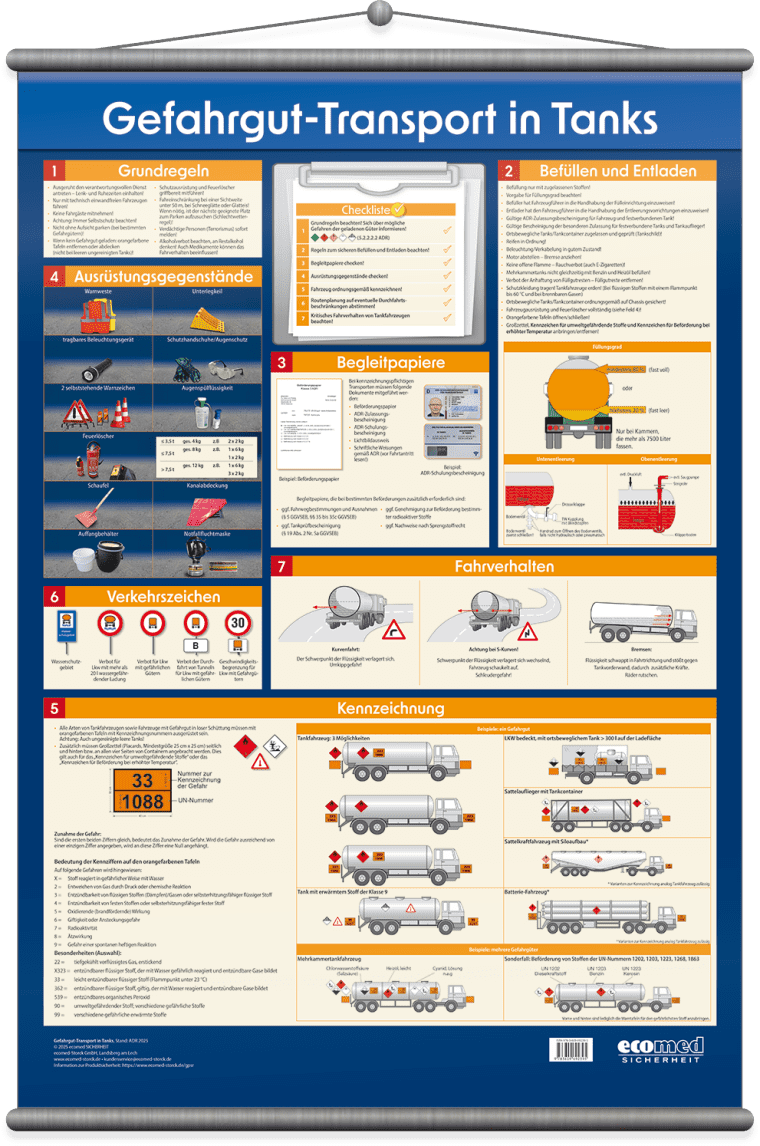
Wall chart, format 70.0 x 100 cm Transporting dangerous goods in tanks according to ADR 2017: everything you need to know at a glance Do you transport dangerous goods in tankers? Then you should have this wall plaque hanging on your vehicle so that your drivers can check how to transport dangerous goods safely and in compliance with the current ADR before setting off. And this is illustrated on the wall panel - based on a checklist with the eight most important points to be observed in the transport process - in clearly arranged display boxes: Basic rules: Do you know the nine basic rules for transporting hazardous goods? Your drivers should follow them to avoid accidents. Hazard classes/hazard labels according to ADR: A clear table describes the hazards posed by the individual hazard classes. Loading and unloading: What do drivers need to pay attention to here? The important rules are illustrated using graphics. Accompanying documents: Which documents must be carried and when? The quick check for the driver!Equipment: What equipment should drivers have with them? Use the overview on the wall panel to quickly check your inventory before you set off.Labelling: Tanker, articulated lorry, tank container, large container, skip loader: Which vehicles must be labelled, how and where? The most important regulations, a list with the meanings of the code numbers on the orange-coloured plates and diagrams for attaching the hazard labels and plates provide information.Traffic signs: Which special dangerous goods traffic signs mean what? The blackboard explains the signs.Driving behaviour: How does the loaded liquid behave during the journey?Behaviour in the event of an accident: What do drivers need to remember in the event of an accident? A yellow warning box points this out to them.The wall panel is also ideal for training purposes. The sturdy mounting and suspension system of the wall panel guarantee long-term use.
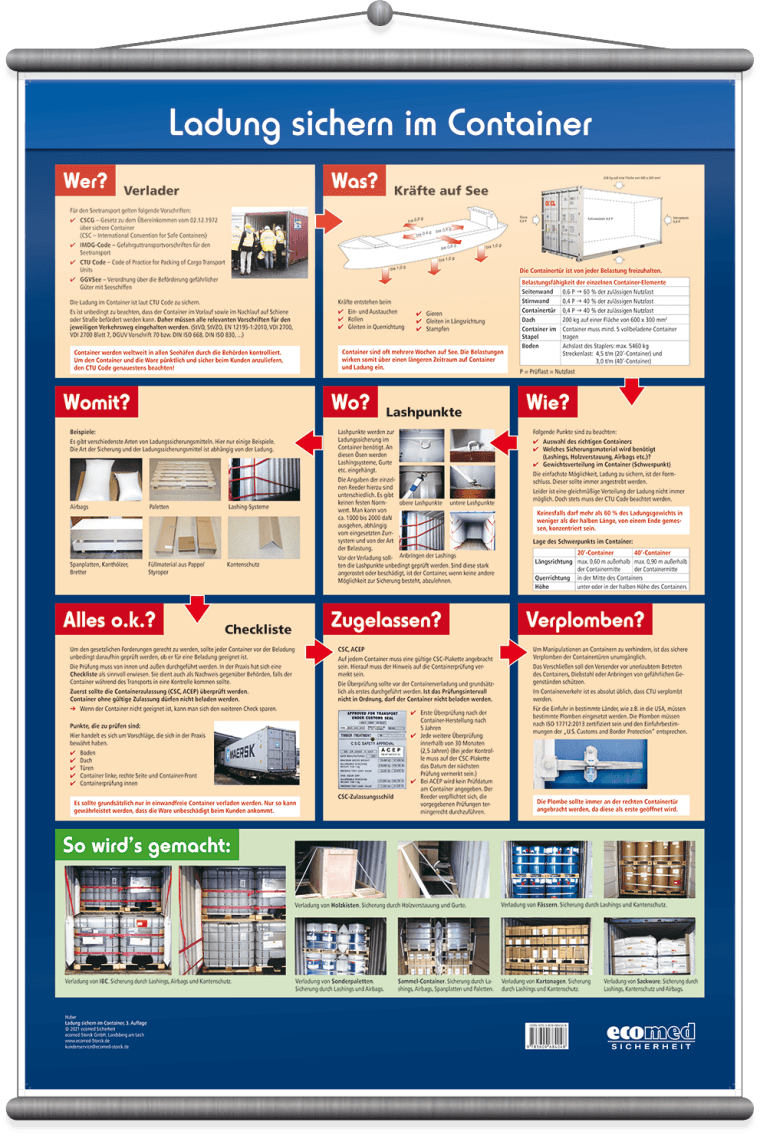
Use the practical quick overview for securing cargo in overseas containers! Containers are inspected by the authorities in all seaports worldwide. Incorrectly loaded containers harbour a high risk for the cargo, but also for the means of transport and the handling personnel. Due to the extremely high loads during a sea voyage lasting several weeks, the cargo must be secured with particular care and in accordance with the regulations. This 70 x 100 cm wall panel shows the most important information for CTU loaders in words and pictures, such as - Legal regulations - Forces at sea - Container superstructure, loads - How do I secure correctly? - Lashing points - Load securing equipment - Container inspection - Sealing - Examples of correct load securing
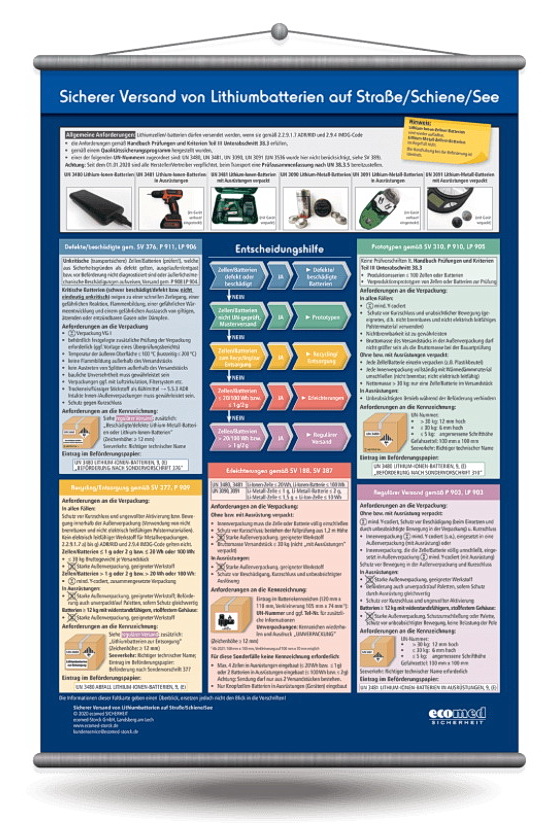
Wallposter, format 70.0 x 100 cmHow to get lithium-ion batteries and lithium-metal batteries safely from A to B.Based on a central decision-making aid, the blackboard shows you what is particularly important when shipping lithium cells/batteries, so that you are on the safe side in terms of dangerous goods. This covers all transport cases on the road, as well as rail and sea routes. Example images sharpen the view of what falls under which UN number.With a few key questions, the decision-making aid puts shippers and packers on the right track:Are the cells/batteries defective or damaged? Depending on the degree of damage, there are sometimes very strict requirements (according to SV 376, P 911, LP 906), which are briefly listed. Special packaging should be chosen that can prevent self-ignition of the cells/batteries.Different rules apply to battery recycling and the shipment of prototypes: SV 377 and P 909 for disposal, SV 310, P 910 for the prototypes.The same applies to small batteries/button cells - there are simplifications here (SV 188). But there are still some basic rules to be followed.Of course, the specifications for regular shipping according to P 903 and LP 903 are also on the blackboard.For all these cases, this blackboard answers the following questions briefly and clearly:Which requirements does the selected packaging have to meet?How is the package to be marked?Which entries must be in the transport document?Currently only available in German! Feel free to contact us if you need another language.
